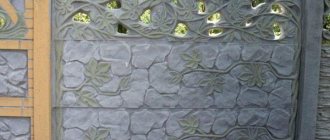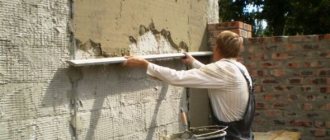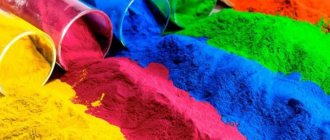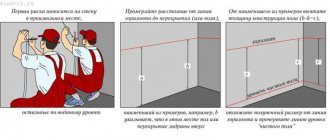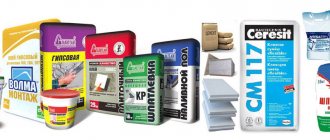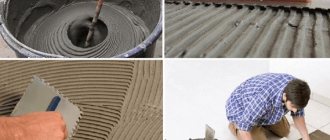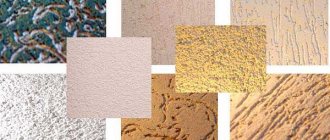Specifications
The composition of such a solution must include cement, sand, slaked lime and water.
It is worth paying attention to the fact that it is slaked lime that needs to be added. Otherwise, the quenching reaction will begin in the solution itself when water is added, and bubbles, forming inside the solution, will lead to cracking of the plastered surface
This process of bubble formation will lead to deterioration in the quality of the solution and to brittleness after it dries.
Construction mixtures, their composition and properties are regulated by various GOSTs. This is necessary for standardization and regulation of norms in construction. GOST 28013-98 is the main legal act regulating the technical requirements for building mortars and materials included in the composition.
This standard also includes characteristics of quality indicators, acceptance rules and conditions for transportation of finished solutions. It contains the qualitative and quantitative characteristics of masonry mortars, materials for plastering and for interior work, used in various operating conditions.
Advantages and disadvantages of lime plaster
If we talk about the positive aspects of this material, the following especially stand out:
- The material does not burn and does not support combustion.
- Lime plaster, after drying, demonstrates high thermal insulation properties, which will allow you to save on home insulation.
- The mixtures are elastic, making them easy to work with.
- Mold, fungi and pathogenic bacteria cannot develop on such surfaces due to the high alkalinity of the material.
- Lime plasters allow steam to pass through, so moisture will not accumulate under the coating.
- If the manufacturing and application technology is followed, the surfaces will not crack under mechanical stress, for example, driving in nails.
- Lime mortars can be applied to any type of surface, including heavy and light concrete, brick, wood, and drywall.
Lime mortars can easily be applied to any type of surface.
Their disadvantages should be noted as follows:
- Lime plaster takes a long time to dry, and the next layer can only be applied to a dry surface, so plastering one room can take up to a month.
- To prepare the solution, slaked lime is required. If there is none, then you will have to carry out the extinguishing procedure yourself, which takes about two weeks.
Cement mortars
Cement is prepared from a mixture of ordinary cement and medium sand. The proportions can be different, they depend on the brand of cement used and can be: for one part of cement, take from three to six - sand.
Mix the dry mixture with the addition of water until a homogeneous mass is formed.
First, the dry mixture is mixed, then water is gradually added, then everything is mixed until a homogeneous, thick mass is obtained. But this option is not the best, since ordinary cement is inactive, even when using any brand it turns out to be too hard and too strong.
The cement-lime composition for bricklaying consists of lime and cement. The cooking process is as follows:
- Slaked lime, that is, lime dough, is diluted to the state of thick milk, and then filtered through a sieve.
- A dry mixture is prepared based on sand and cement, which is dissolved with lime milk, after which it is thoroughly mixed. Adding lime can increase the plasticity of the resulting mixture; this mixture is recommended for use for laying any type of brick.
Simple masonry mortar
The simplest solution is prepared from a binder (it can be ordinary cement or lime) and sand. In some cases, clay can also act as a binder, but this is very highly specialized work that is not performed very often.
The most common cement-sand mortar has the following proportions: one part of cement to three of medium-fraction sand. The resulting mixture is thoroughly mixed first in dry form, after which plain water is gradually added to it. Stirring is carried out until the resulting composition acquires the proper density and mobility.
Checking such characteristics is not so difficult: the container in which the solution is mixed must be tilted at an angle of forty degrees; if the mixture does not pour out, then you can begin the masonry process.
Complex installation solution
The solution should not spread or slide well off the surface.
A complex brick mix is a mixture of several components and a binder material that affects the physical characteristics. Among such complex mortars for brickwork, cement-lime-clay, cement-lime and others are used, thanks to which the masonry is simpler, but also reliable.
Clay, for example, is added to make the composition more plastic. It does not fall apart during operation and is installed very neatly and easily. The use of plasticizers makes the brick mixture indispensable when laying facade walls. This mixture is very economical, it provides uniform compaction, and when spread, it is conveniently leveled over the surface of the previous row. Therefore, many experts recommend spending a little more time preparing the solution, but then this will only help in the work.
How to prepare lime plaster and plaster walls - step by step diagram
Step 1: Prepare the solution
You need to select a different solution for each wall so that the base adheres securely to the layer of plaster. If you need to plaster a concrete or brick surface indoors, both standard lime and lime-cement compositions, as well as lime-gypsum, are best suited. It is better to treat wooden elements with lime-gypsum mortar. When kneading, use one little trick - add water not in a direct stream, but by passing it through a watering can, so the liquid will flow more evenly, which will make the kneading process easier.
Step 2: Spray the surface
Spraying is a very important step and should not be neglected. This procedure increases the adhesion of subsequent layers to the wall. To spray, you need to make a liquid solution of two parts sand, one part cement and one fifth part lime. Using a trowel, the prepared mortar is applied to the wall in as thin a layer as possible. There is no need to level it.
Step 3: Base coat of plaster
The soil, or base layer, should not be made more than 5 cm thick. A classic lime composition or a complex composition of lime and cement is prepared for it. Experienced craftsmen apply the mortar with a trowel and level it with a trowel; for beginners it will be more convenient to work with one trowel at first. Apply the solution from top to bottom, using wide movements. Excess must be removed using a rule - a special plaster cutter. Be sure to check for evenness both vertically and horizontally.
Mixture proportions
There is a classic version of the mixture, which is determined by the ratio 1:3 - 1 part cement and 3 parts sand. Both components are first mixed dry with each other, and then water is added to this mixture in portions. All this is thoroughly mixed until a solution is formed, the consistency of which is similar to thick sour cream. Be sure to give the finished mixture 15 minutes to thicken, after which it is mixed again.
By the way, the cement-sand mortar “lives” for no more than 1.5 hours. After which it begins to lose moisture and dries out. So a small batch is a justified decision.
To mix the components, it is recommended to use a construction mixer or a drill with a special attachment. If you need a large volume of material, for example, to pour a foundation, then we recommend carrying out the preparation process in a concrete mixer
Please note that the end result is a lump-free composition in the form of a homogeneous mass
Sand for masonry mortar
Main ingredients of the solution:
Cement is a binding component. It must be in paper bags. It is recommended to buy it before starting construction processes. That is, it must be “fresh”. After all, during long-term storage this material cakes, which means it loses its qualities. Sand is a filler. There is one point regarding quality here. There should be no foreign materials in the sand. This is especially true for clay. Therefore, it is recommended to purchase river sand
Pay attention to the fraction of the material. For example, fine material promotes the spreading of the mortar, so it is not used for masonry mixtures. But in screed mortars, such sand is an ideal choice
The coarse fraction is not used for preparing plaster, although it works great in foundation mortars. Water is the basis, so it must be clean. The main requirement for it is the absence of acid and oil impurities.
Features of choosing a brand of solution
Now you can move on to the proportions and understand such an indicator as the brand of solution:
- The masonry composition is grade M100. It is used in the construction of walls and barrier structures made of bricks or blocks based on different materials. To do this, you will need M400 cement and sand, which are mixed in a ratio of 1:4.
- To increase the strength of the masonry, you can use M200 grade mortar. To do this, you will have to reduce the amount of sand by 2 times.
- To level the floor bases, the M300 grade of mortar is used. To do this, you can use cement M400 or M500 with the addition of water and sand in a ratio of 1:3:0.5.
- To plaster the walls, use exactly the same solution as above, only with a slight increase in the amount of cement. For example, it could be 1.2-1.5. Plaster mortars are often made with the addition of lime milk. This reduces the strength of the material, but increases its ductility. In this case, the cement-sand-milk ratio will be 1:5:2.
Standard proportions
Making the solution in the correct ratio
There are certain technological standards that regulate the ratio of building mixture components. Here are three examples:
- To prepare the screed solution, use proportions of 1:2-1:6. In this case, the amount of water is not indicated, but only the cement-sand ratio is indicated.
- In low-rise construction, 1:3 or 1:4 solutions are most often used.
- For erected structures - from 1:3 to 1:6.
Why don't the standards specify water? The fact is that it is easy to make a mistake with the volume of water. After all, the sand may be wet, and it is impossible to determine the degree of humidity at home. At the factory, this indicator is strictly controlled. What can you offer to those who use handmade solutions? To do this, it is better to double the batch if the first one turns out to be liquid. Just add cement and sand to it according to the standard, but reduce the amount of water.
3be072818ab0367a28183b8064b824bf.pic
Today, facing tiles and stone are placed on ready-made adhesive mixtures, which greatly simplifies the process of preparing the composition. But since we are considering all cement-sand mortars, we should not ignore this masonry material. Let's just designate the proportions - 1:2.4:0.4. This is such a non-standard ratio.
Many people ask a question regarding determining the volume of one serving. What means and instruments can be used to measure the required amount of material? Construction stores sell special measuring buckets, with the help of which the building mixture is measured or weighed.
Preparation of various types of lime compositions
The simplest and cheapest lime plaster is prepared as follows:
- Slaked lime must be ground through a 3 mm sieve, then add a little water until a “dough” is formed.
- Add sand to lime in proportions 1:3.
- Mix thoroughly, let it sit for 30 minutes, mix again, after which the process of making lime-sand plaster is completed.
- To improve performance characteristics, other binders are added to lime.
Sand and slaked lime are the main components of a standard lime mortar for plaster.
Lime-gypsum mortar
This solution option is used only for interior decoration, since gypsum is even more hydrophilic than lime, so this coating is not protected from water. The main advantage of this type of plaster is the drying speed. The material begins to set within 5 minutes after mixing, and after half an hour it hardens. In this case, the time to gain strength is 1-2 days. The finished coating is characterized by mechanical strength and attractive appearance, so it does not need to be decorated.
You should know! Lime-gypsum plaster dries very quickly, so you need to prepare it in small portions of approximately 5 liters.
The difficulty of working with lime-gypsum mortar is that the plaster dries quite quickly.
To prepare such a mixture, you need to carry out the following manipulations:
- Prepare 2 liters of lime paste (grind slaked lime and add a small amount of water).
- Place the dough in a container and pour 1 liter of gypsum into it.
- Mix thoroughly using a drill or hammer drill with a mixer attachment.
- While mixing, you need to add water.
- Then add another 2 liters of lime paste and mix everything again, after which the lime mortar can be used for plaster.
To mix the solution, it is best to use a drill or hammer drill with a mixer attachment.
To slightly increase the setting time, you can add a small amount of PVA glue to the solution (50 ml of glue will be enough for 5 liters of plaster). You can also add more liquid for this purpose, but then the finished coating will not be as durable.
Lime-clay mortar
This composition was previously used everywhere, but with the development of new technologies it faded into the background. The main advantages of such plasters are their relatively low cost and absolute environmental friendliness. Lime-clay mortar has low mechanical strength, so various fillers are added to it: sand, sawdust, straw. In the past, metal shavings were used, but they were soon abandoned due to their susceptibility to corrosion. For preparation you will need the following components:
- alumina;
- sand or other filler;
- lime dough;
- water.
Components for preparing lime-clay mortar
If the lime has already been quenched and ground, then you can begin preparing the clay. To do this, place it in a separate container and fill it with water. So the clay should stand for about 2-3 days, after which you need to knead it thoroughly. The excess liquid is drained and the clay is kneaded again until a viscous, homogeneous material is obtained.
Then you need to make lime dough and mix it with clay dough. Next, water and sand are gradually added, constantly stirring the plaster. It is important to maintain the average fat content of the solution. If a large amount of plaster remains on the stirring tool, then you need to add a little water. If the working material does not stick to the mixer at all, add a little lime. One part of lime dough will require 1 part clay and 2 parts sand.
The process of preparing lime-clay plaster
Lime-cement mortar
This type of plaster is most often used for finishing rooms with high humidity levels. The finished coating requires further decoration with special plaster or ceramic tiles. The presence of cement in the solution ensures the strength of the coating, and lime ensures the plasticity of the material. For preparation you will need river sand, cement and lime paste.
If the composition will be used for rough finishing, then class M200 is sufficient. If further decoration is not expected or you plan to hang furniture or appliances on the wall, then it is better to use Portland cement grade M400 and higher. One part of lime paste will require 1 part cement and 3 parts sand.
Ready-made lime-cement mortar
How to make lime-cement plaster:
- First of all, mix the dry substances: sand and cement.
- Next, dilute the lime dough with water until a liquid “milk” is obtained.
- The resulting liquid is poured into a container with dry materials.
- Using a drill, stir the plaster and add water if necessary.
Requirements for masonry mixture
The requirements for masonry mortars are described in detail in GOST 28013-98. According to this document, the following requirements apply to mortar mixtures:
- the composition must have a high degree of adhesion to brick and other substrates;
- withstand large amounts of freezing and defrosting;
- to ensure that the masonry does not collapse under the influence of atmospheric influences and temperature changes, the masonry mixtures must have high water resistance;
- due to the plasticity of the mortar, during the laying process, it becomes possible to timely adjust the position of the masonry material, which significantly increases the quality and productivity of the work;
- water-retaining properties prevent decomposition of the mixture and precipitation of heavy fractions;
- the strength characteristics of the composition are decisive in the calculation of building structures. This parameter shows what maximum loads the material can withstand. The brand of the solution reflects its strength in kgf/cm2.
Failure to comply with these requirements leads to the formation of cracks in the brickwork, increased consumption of the mortar mixture, increased thickness of the joints and reduces work productivity.
Requirements for plaster
To obtain the required level of durability and strength of the layer, it is necessary to know the properties that are important for the mixture when choosing. Experts note the following points:
- The strength indicator must be greater than M50;
- Frost resistance is at least 35 cycles of freezing and defrosting;
- The level of adhesion is approximately 4 kg/cm2;
- The grain size is ideal up to 1 millimeter;
- The optimal thickness for applying plaster should be in the range of 5-30 mm.
When purchasing, it is recommended to request a certificate of conformity from the seller.
To obtain the required level of durability and strength of the layer, it is necessary to know the properties that are important for the mixture when choosing.
Making sawdust concrete with your own hands
Independent production of lightweight concrete composite is carried out according to the following algorithm:
- The necessary materials are being prepared. There is no need to purchase components in advance. All components can be prepared immediately before production by visiting stores or building materials warehouses, as well as using waste from woodworking enterprises.
- The ingredients are mixed according to the proportions. Mixing of components can be carried out mechanically using a concrete mixer or manually using shovels. Automation of the technological process through the use of a concrete mixer increases productivity, improves mixing intensity, and has a positive effect on product quality.
- Molding is in progress. The group molding process is predominantly used, when the pre-mixed composition is poured into several dozen molds. Single and group forms of collapsible design are used, made of wood 2 cm thick and upholstered in metal or plastic. The use of polyethylene film makes it easier to remove finished products.
- The finished product is dried naturally. The molds are removed 4–5 days after pouring by loosening the wing nuts, removing the threaded rods and disassembling the molding box. The natural drying process lasts, depending on the type of wood, up to three months, during which the moisture concentration is significantly reduced and the product acquires operational strength.
Standard composition of concrete with sawdust: cement-sand mixture, wood shavings, lime (if necessary)
Scope of application of lime mortars
Mixtures of this type can be used when finishing internal and external surfaces. Depending on the composition, the solution is used to cover walls in residential, commercial, public and industrial premises. It is permissible to use lime plaster to decorate open and closed balconies, facades and plinths of buildings.
There are some restrictions on the use of lime-based compositions:
- It is not recommended to finish surfaces in rooms with high humidity, for example, in basements, cellars, bathrooms, as well as external walls of buildings located in humid climatic zones.
- Plastering walls with lime mortar is also not recommended if furniture or equipment will be hung on the surface.
Lime mortar is not recommended for plastering the facade of a building located in a humid climate zone.
According to current SNiP, the maximum permissible air humidity when plastering surfaces with lime mortars is 65%.
Why are plasticizers needed?
Plasticizer is a special compound added to the solution to increase its plasticity and elasticity.
Beneficial effect of using a plasticizer:
- Reducing the amount of water that impairs the hardening of the solution.
- Increasing the moisture resistance of the seam.
- Increased frost resistance.
Plasticizers have different purposes:
- Catalysts. Serve to speed up and increase the strength of the hardening of the solution.
- Modifiers. Allows you to obtain additional capabilities of seams - greater resistance to mechanical stress, moisture resistance, etc.
In addition, plasticizers make it possible to obtain a more elastic seam that compensates for thermal expansion of the cladding. This ability helps maintain the strength of connections with the load-bearing wall and prevents the appearance of cracks in the seams that can accumulate moisture.
Making your own solution
First you need to slak the lime for the plaster so that it is suitable for work. This requires a metal container, since the reaction is accompanied by a large release of heat and an increase in volume by 3 times. The lime packaging indicates the slaking speed: slow (25 minutes or less), fast (8 to 10 minutes), medium, 15 to 20 minutes. It is better to mix the mixture with a shovel or oar. Slaking is carried out for at least a day, however, ideally use lime that has been standing for a month.
The note! The sand also needs to be prepared before preparing the plaster: remove impurities, clean it by passing it through a sieve.
Instructions for creating a limestone-sand mortar:
- Sand is mixed with lime paste in the selected proportion. This is done dry and mixed thoroughly.
- After which water is gradually added to the container. There is no need to pour in the entire volume at once; it is poured in in a thin stream, and the solution is constantly stirred.
Now that the preparation is complete, you can begin plastering the surface.
What is lime plaster
Adding lime to solutions can significantly increase the ductility and crack resistance of plaster. It becomes much easier to work with, it does not dry out as quickly, it even sticks easily to wood, and the surface is smoother and free of defects. It also provides excellent protection against mold and mildew. Another indisputable advantage is its environmental friendliness - unlike synthetic additives, lime is absolutely harmless.
Lime is widely used in construction as a plasticizer. However, when plastering facades, it should be taken into account that it can only be used in areas with a dry climate. Such solutions are not recommended for use in rooms with high (over 60%) humidity.
Lime plaster is considered warmer and more vapor-permeable, that is, “breathable,” and it is much easier to remove it from the walls in case of repairs than, for example, ordinary cement plaster. But excess lime can weaken the strength of the surface. That is why it should be added in moderation, strictly adhering to the proportions.
As you can see, lime plaster has many advantages. The disadvantages include not such high strength as that of cement compositions. It is also not recommended to use it in damp areas and
But such a solution does not require special strength. After all, the purpose of plastering is to level the surface and cover up small cracks. A more durable solution is required when laying. However, even in this case, according to SNiP, it is allowed to add a small amount of lime paste or clay to it to increase plasticity.
When slaking lime, you should be extremely careful - splashes of the hot mixture can cause burns. The smallest lime dust that can settle on the mucous membrane also has a harmful effect. Therefore, when working, you should use protective clothing, gloves and a respirator.
Application of cement-lime plaster
Plaster must also be applied in several stages. If the surface is prepared and the solution is mixed, it should be used within 3-4 hours. The process can be divided into three stages.
If the surface is prepared and the solution is mixed, it should be used within 3-4 hours.
Splash
This method allows you to reliably adhere the plaster solution to the base. The mixture is made thinner than usual; a trowel is used as a tool. The layer is sprayed thinly onto the base, after which the plaster is leveled with a tool. The first layer needs to dry for 2-3 hours, after which they move on to the next stage.
This method allows you to reliably adhere the plaster solution to the base.
Base layer
This layer can be made up to 50 mm thick; the solution is thicker than the previous one; a trowel or trowel is used for application. They operate from top to bottom. Excess parts must be removed using a rule.
This layer can be made up to 50 mm thick; the solution is thicker than the previous one; a trowel or trowel is used for application.
Finish coating
The finishing coating is made for wallpaper or for painting. The solution is prepared similar to that for spraying. Special graters are used to help create a smooth surface without small flaws.
The beacons will need to be removed by filling the voids with mortar and carefully leveling them at the end of plastering. Occasionally, beacons remain in the wall.
Special graters are used to help create a smooth surface without small flaws.
Working with cement-lime plaster is standard, but it is important to properly prepare the solution itself. Take into account that lime must be slaked using a special method, which is described above. The plaster is universal, so it is suitable for different purposes.
Preparation of masonry mortars
Since various types of mixtures can be used for masonry mortar, let us consider in more detail how to prepare mortar for bricklaying.
Cement mortar proportions
Sand-cement compositions are widely used in capital construction and other areas where increased demands are placed on the strength characteristics of brickwork.
When starting to prepare masonry mortar, you should remember that excess cement in the working mixture does not increase its strength, and in some cases, even worsens its characteristics. Only strict adherence to dosage will ensure optimal performance properties of the masonry mixture. The proportions of the most common cement-based compositions are given in SP 82-101-98, which clearly regulates the percentage of ingredients in various types of cement masonry mixtures.
The table shows the percentage of ingredients in cement masonry mortar, depending on the brand of cement used.
| Brand of masonry mixture | Cement brand | Ratio cement/sand |
| M25 | M300 | 1/9,5 |
| M50 | M300 | 1/5,8 |
| M400 | 1/7,4 | |
| M 75 | M 300 | 1/4,2 |
| M 400 | 1/5,4 | |
| M 500 | 1/6,7 | |
| M 100 | M 300 | 1/3,4 |
| M 400 | 1/4,3 | |
| M 500 | 1/5,3 | |
| M 150 | M 300 | 1/2,6 |
| M 400 | 1,3,25 | |
| M 500 | 1/3,9 |
Scope of application of cement mortar depending on strength characteristics
Below is the scope of application of different brands of masonry mortars.
- M25.
Used for plastering and floor screeding. The composition does not contain any additional ingredients. - M 50.
Used for brick and stone masonry in the construction of low-rise buildings and structures. May contain plasticizers, dyes and other additives. - M 75.
Used for laying concrete slabs, installing reinforced concrete structures, erecting internal partitions and installing concrete floor screeds. - M 100.
Widely used in monolithic construction, masonry work and pouring light-loaded strip foundations. - M 150.
Used primarily for foundation work on loose soils.
Proportions of cement-lime mortar
The percentage ratio of cement, lime and sand in cement-lime mortar is given in the table.
| Cement/lime/sand ratio | |||||
| Cement brand | Masonry mixture M 50 | Masonry mixture M 75 | Masonry mixture M 100 | Masonry mixture M 150 | Masonry mixture M 200 |
| M 300 | 1/0,6/8 | 1/0,3/4 | 1/0,2/3,5 | 1/0,1/2,5 | |
| M 400 | 1/0,9/8 | 1/0,5/5,5 | 1/0,4/4,5 | 1/0,2/3 | 1/0,1/2,5 |
| M 500 | 1/0,8/7 | 1/0,5/5,5 | 1/0,3/4 | 1/0,2/3 |
The solution is prepared in the following sequence:
- Fluffed lime is diluted to the consistency of kefir, and then filtered.
- Separately prepare a dry sand-cement mixture.
- Strained lime is added to the cement-sand mixture and mixed thoroughly until a homogeneous mass is obtained.
Proportions of cement-clay mortar
The ratio of cement, clay and sand in a cement-clay masonry mixture is given in the table.
| Brand of masonry mixture | Cement M 500 | Cement M 400 | Cement M 300 |
| Cement/clay/sand ratio | |||
| M 300 | 1/0,15/2,1 | 1/0,07/1,8 | |
| M 200 | 1/0,2/3 | 1/0,1/2,5 | |
| M 150 | 1/0,3/4 | 1/0,2/3 | 1/0,1/2,5 |
| M 100 | 1/0,5/5,5 | 1/0,4/4,5 | 1/0,2/3,5 |
| M 75 | 1/0,8/7 | 1/0,5/5,5 | 1/0,3/4 |
| M 50 | 1/0,9/8 | 1/0,6/6 | |
| M 25 | 1/1,4/10,5 |
The addition of clay increases the ability of masonry mixtures to retain moisture.
The low strength of lime mortar prevents its widespread use in masonry work. Most often, lime mixtures are used for plastering work. The proportions of the working solution depend primarily on the fat content of the lime and can range from 1/2 to 1/5.
Concrete mortar and its composition.
Cement should only be stored in a closed, dry place! Per 1 bag of cement, the dosage of concrete mortar is as follows:
| Cement binder material | Dry construction sand filler | Water | Plasticizer Added to cement mortar for high plasticity |
| Purpose | Cement | Dry construction sand Fraction 0.5 mm Density 1.5 g/m3 | Water approximate amount | Plasticizer |
| Construction of walls from concrete blocks Example: blocks 20x20x50 cm by 7 m2 | 50 kg | 190 kg or 127 l | 25 l | |
| Construction of brick walls Example: brick 120x250x65 mm per 7 m2 | 50 kg | 190 kg or 127 l | 25 l | + |
| Concrete floor screed | 50 kg | 200 kg or 135 l | 25 l | |
| Traditional facade plaster for 20 m2 First layer 3-5 mm | 50 kg | 250 kg or 167 l | 25 l | |
| Cement-lime second layer Soil 15-20 mm | 50+50 kg | 250 kg 167 l | 25 l | + |
| Cement-lime third layer Covering 5-7 mm | 20 kg | 190 kg 127 l | 25 l | + |
| Grout for joints on a stone wall | 50 | 190 kg 127 l | 25 l | |
| Grout for joints on a brick wall | 25 kg | 95 kg or 63 l | 13 l | + |
This solution is used for various construction works (screed, foundation, floors, beams). Steel reinforcement is placed into concrete to increase strength, resulting in reinforced concrete. Bonding the reinforcement to the mortar makes it easier for the metal surface to oxidize.
| Cement binder material | Dry construction sand filler | Gravel filler | Water |
| Purpose | Type of fittings | Cement in bags of 50 kg | Dry construction sand Fraction 0.5 mm Density 1.5 g/m3 | Crushed stone for concrete Fraction 20-40 mm Density 1.6 g/m3 | Approximate amount of water |
| Concrete screed, garage floor, terrace | Welded reinforcement mesh | 8 | 1200 kg (90 kg/bag), or 800 l (60 l/bag) | 850 kg (176 kg/bag), or 530 l (110 l/bag) | 175 l |
| Foundation | Foundation mesh | 8 | 1200 kg (90 kg/bag), or 800 l (60 l/bag) | 850 kg (176 kg/bag), or 530 l (110 l/bag) | 175 kg |
| Beams, floors | Square reinforcing mesh, smooth or corrugated steel rod | 8 | 720 kg (90 kg/bag), or 490 l (60 l/bag) | 850 kg (130 kg/bag), or 530 l (81 l/bag) | 200 l |
Calculation of the required volume of concrete is calculated using the formula:
Volume of concrete = Length x Width x Height, for example: 10 x 5 x 0.1 m = 5 m3
When adding water to a solution or building mixture, the following proportions must be observed:
Volume of water = Weight of cement / 2, for example: 25 liters of water per bag of cement weighing 50 kg.
Preparation of simple plaster compositions
Cement mortar is the simplest and most common.
Simple plasters include those mortars based on a single binder. These include the following plaster solutions:
- Cement.
- Lime.
- Clay.
- Plaster.
Cement
This composition is the most common type of finishing: its consistency is very similar to brick laying mortar. However, the density in this case is different, and the use of various additives and plasticizers is widely practiced.
Although this may sound unexpected, what most closely requires personal control is the quality of the sand used. That is why, before use, it is carefully sifted through a special sieve to remove all impurities and debris.
After cleaning the sand, the mixing procedure begins: the main components must first be mixed dry. The proportions of cement mortar for plastering walls outside the room are taken in a ratio of 1:5 sand to M500 cement. As for the interior finishing, in this case cement is mixed with sand 1:4, where M400 cement is used for preparation. After the dry ingredients have acquired the required homogeneity, water is added to the composition and stirred until it becomes mushy. To carry out such a procedure, both a trough and a construction mixer can be used.
Lime
In lime mortar, lime acts as a binder.
This composition differs from the previous one in the absence of cement: in this case, lime is used as a binder: it must only be slaked and have excellent qualities. The first step is to thoroughly grind it so that the particles are as small as possible. Then water and sand are added to the vessel with lime powder, constantly mixing the entire material
It is very important that the resulting lime mortar for plaster does not contain lumps, with the density of the mixture resembling dough. Then another portion of purified sand is added to the resulting mass in a ratio of 3:1
After this, the final stirring of the plaster is carried out by adding water: the finished consistency of the solution should resemble thick sour cream.
Clay
This easy-to-prepare plaster mortar is the oldest known. With the development of construction technologies, its composition has undergone some changes, because clay in its pure form is quickly washed off by rain. To strengthen the finish, it is practiced to add cement, lime and gypsum, which helps to increase its durability and reliability: while maintaining the availability of preparation. In the process of preparing clay plaster, the main component must be thoroughly cleaned of all kinds of debris and impurities. Then clean and dry clay is soaked in water for 3-5 hours until it is completely soaked: the preparation of the solution is completed by adding sand to its composition, at the rate of 2-4 parts of sand to one part of the clay mixture. Typically, clay plaster is used to decorate interior spaces.
Gypsum plaster
Most often, final operations on leveling walls are carried out using gypsum plasters, with the possibility of application not only on concrete and brick, but also on wooden bases. The first recipe for preparing such a solution involves using 3 kg of chalk and 1 kg of gypsum, while the chalk is crushed to dust, and then mixed with gypsum. In this case, water is not used, since 5% wood glue is used as a solvent. The proportions of glue in this case vary, depending on the required thickness of the final solution. This type of solvent not only makes the mass of plaster homogeneous, but also allows you to somewhat slow down the hardening process. However, the drying speed of gypsum plaster is still quite high.
Working with gypsum plaster requires skill, as the mixture dries quickly
The second method of preparing a finishing mortar from gypsum is especially suitable in cases where it is necessary to plaster painted bases or chipboard partitions. In this case, you will need to take 2 kg of gypsum, 1 kg of drying oil and 100 g of drier: after thorough mixing, the composition must be immediately prepared. The reason for this is the lightning-fast drying of the drier: when working in this case, you will need appropriate construction skills.
Proportions of cement mortar for brickwork
For brickwork, as for plaster, cement-lime or cement mortars are created. However, it must be taken into account that in this case the grade of mortar should not be higher than the strength class of the bricks used for masonry. It is most convenient to work with plastic mortar: it is easy to apply, but does not drain from the masonry elements. In order to prepare a mixture with optimal consistency, you need to know the most successful ratio of all components of the solution.
Preparation of branded cement mortars
The brand of mortar depends on the ratio of cement and sand in the mortar. The more sand and less cement, the less durable the solution is and, accordingly, the lower its grade.
- 1 part cement: 5 parts sand - the proportion of preparation of the MZ grade solution;
- 1 part cement: 4 parts sand - the proportion of preparation of the M5 grade solution;
- 1 part cement: 3 parts sand - the proportion for preparing the M8 grade solution.
Recipe for plastic cement mortar M3 for brickwork
To create 1000 liters of M3 grade solution you need:
- water – 340 l.;
- sand – 2064 kg;
- cement – 268 kg.
To create 200 liters of M3 grade solution you need:
- water – 54 l.;
- sand – 206 l. (330 kg.);
- cement – 33 l. (43 kg.).
To create an M3 mortar from a 25-kilogram bag of cement, you need:
- water – 32 l.;
- sand – 120 l. (192 kg);
- cement – 25 kg.
Recipe for plastic cement mortar M5 for brickwork
To create 1000 liters of M5 grade solution you need:
- water – 350 l.;
- sand – 2000 kg;
- cement - 327 kg.
To create 200 liters of M5 grade solution you need:
- water – 56 l.;
- sand – 320 kg;
- cement - 52 kg.
To create an M5 mortar from a 25-kilogram bag of cement, you need:
- water – 27 l.;
- sand – 177 kg;
- cement - 25 kg.
Recipe for plastic cement mortar M8 for brickwork
To create 1000 liters of M8 grade solution you need:
- water – 360 l.;
- sand – 1904 kg;
- cement – 412 kg.
To create 200 liters of M8 grade solution you need:
- water – 58 l.;
- sand – 305 kg;
- cement – 66 kg.
To create an M8 mortar from a 25-kilogram bag of cement, you need:
- water – 22 l.;
- sand – 115 kg;
- cement – 25 kg.
Recipe for plastic cement-lime mortar M3 for brickwork
To create 1000 liters of M3 cement-lime mortar you need:
- water – 470 l.;
- sand – 1760 kg;
- cement – 191 kg;
- hydrated lime – 106 kg.
To create 200 liters of M3 cement-lime mortar you need:
- water – 75 l.;
- sand – 282 kg;
- cement – 30.5 kg;
- hydrated lime – 17 kg.
To create a plastic cement-lime mortar of grade M3 from a 25-kilogram bag of cement, you need:
- water – 61 l.;
- sand – 230 kg;
- cement – 25 kg;
- hydrated lime – 14 kg..
How to prepare cement-lime mortar
Preparation of this type of plaster mortar is simple, the essence is identical to working with the cement-sand type, only one component is replaced with lime. The proportion of standard plaster consists of the following parts:
- 1 large piece of cement;
- 4-5 parts sand;
- Water is added until the desired mass is obtained.
Preparation of this type of plaster mortar is simple, the essence is identical to working with the cement-sand type, only one component is replaced with lime.
Proportions of components for plaster. Table
To plaster the surface efficiently, you need to use only high-quality ingredients. Therefore, it is advisable to use M400 cement, where there are no lumps. The ratio of elements is usually made as follows: 0.2-0.4 parts of lime are taken per part of cement, and 3-4 parts of sand are needed.
You can determine exactly how much to use of each element by knowing what level of strength, thickness and plasticity is required. To do this, study the solution preparation table, which is available on the Internet. You can mix part cement and part lime with six parts sand.
To plaster the surface efficiently, you need to use only high-quality ingredients.
How to properly slak lime. Lime mortar preparation technology
The composition contains lime; it is sold in unslaked form. To obtain a solution with the required characteristics, it is necessary to dissolve the material correctly.
When the material combines with water, harmful fumes are released, for this reason it is necessary to wear a respirator and protective gloves on your hands.
Simply pouring water over the lime is prohibited; the process will go too quickly. Take containers that can withstand high temperatures, not plastic. The volume of water is approximately 5-6 liters per 2 kilograms of lime. Lime is added slowly, while the mixture is stirred.
For the process to be completely completed, you need to wait a couple of hours, periodically stirring the components. As a result, you need to get a white batch, similar in appearance to milk, which is used instead of water to create a plaster solution.
For the process to be completely completed, you need to wait a couple of hours, periodically stirring the components.
The procedure for preparing plaster mortar
To create the solution, a machine method is used; you will need a construction mixer or concrete mixer. For small volumes, you can resort to a drill or manual method.
You can mix the elements in different orders; the standard is to mix cement and sand first, then add lime and water. It is important to obtain a homogeneous mass without lumps.
The prepared solution must be applied within 3-4 hours, after which it loses its properties.
It is important to obtain a homogeneous mass without lumps.
Safety precautions
There are safety rules for preparing the solution. Wear protective clothing and gloves. When mixing ingredients, protect yourself with a respirator and goggles.
When mixing ingredients, protect yourself with a respirator and goggles.

